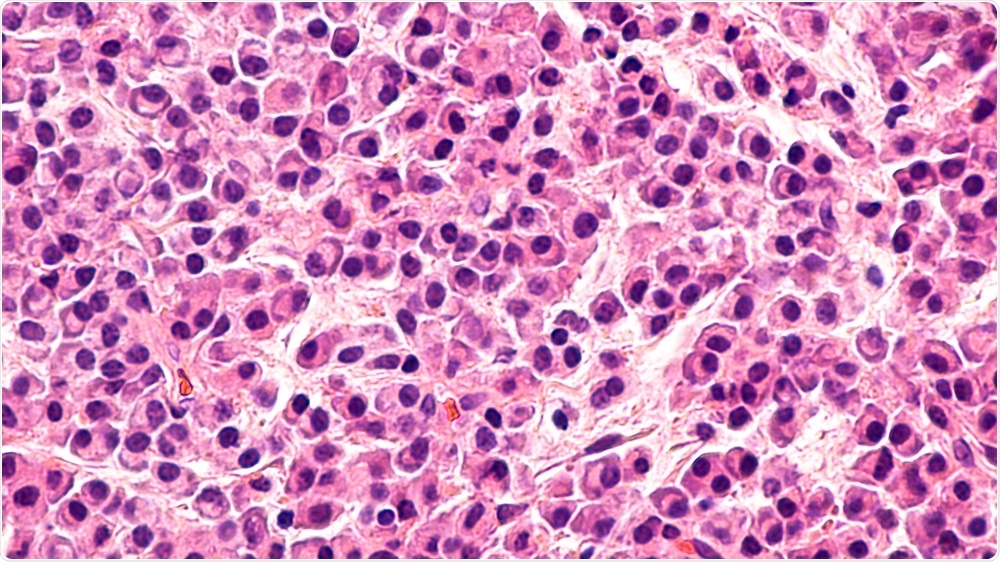A team of Australian researchers has confirmed the feasibility and potential of applying integrated lipidomics and proteomics to malignant plasma cells from myeloma patients.

Image Credit: David. A. Litman/Shutterstock.com
Currently, little is known about the metabolic changes that occur during myeloma relapse, but the current study demonstrated an approach that is likely to provide valuable clinical insights and potentially identify new biomarkers for predicting disease kinetics.
About multiple myeloma
Multiple myelomas (MM) is a form of bone marrow cancer characterized by infiltration of the bone marrow by malignant plasma cells. Many advances have been made in the development of treatment approaches and many more pharmacological agents are now available than previously.
Together, this has increased the median survival time among patients, which may now be as long as six years. However, the relapsing nature of the disease means that almost all patients eventually die and there is an urgent need to understand the underlying mechanisms of relapse and to identify potential new treatments.
The Revised International Staging System (R-ISS) for MM now includes serum lactate dehydrogenase, beta-2-microglobulin, albumin and certain cytogenetic abnormalities as biomarkers that can predict disease behavior. However, it is lacking in accuracy, with patients identified as being at the same risk level experiencing different disease outcomes.
Obesity and cancer
One area where potential disease drivers that may serve as therapeutic targets is emerging is lipid metabolism. This is particularly interesting because researchers have previously reported that obesity is associated with an increased risk of various types of cancer, including MM.
One analysis that pooled data available for 1.5 million people participating in 20 different studies identified that body mass index was associated with the risk of death from MM.
Researchers have also previously suggested that the chronic inflammation observed in cases of obesity may drive MM progression. Some initial lipidomic studies have shown different levels of phosphatidylcholines and membrane fatty acids between malignant plasma cells and healthy ones. However, overall, few studies have investigated the lipid metabolism changes that occur during MM progression and potentially contribute to relapse.
What has this study shown?
As recently reported in the journal PLOS One, Ahmed Mohamed from The University of Queensland Diamantina Institute and colleagues have now evaluated the feasibility of applying concurrent lipidomic and proteomics to assess malignant plasma cells from patients with MM. They have also established hypotheses that they say should be explored in the future.
Using liquid chromatography-mass spectrometry, the team carried out untargeted proteomics and untargeted and targeted lipidomics on plasma cells isolated from seven fresh bone marrow aspirate samples.
The team conducted two types of comparison studies, one looking at high- versus -low-risk patients and one looking at relapsed versus newly-diagnosed patients.
One challenge faced in multiomics analyses of clinical samples is the small amount of patient material. For this study, the team tested the feasibility of applying proteomics and lipidomics to the same plasma cell sample.
To support their results, they compared the proteomics findings in the relapsed group with a dataset from the Multiple Myeloma Research Consortium reference collection and compared the lipidomics findings against a transcriptomics-proteomics lipid metabolism network for MM.
What did the researchers find?
After observing no significant difference between the high- and low-risk individuals, the team concentrated on the relapsed versus newly diagnosed patients.
The untargeted and targeted lipidomics showed that in the case of relapsed MM, there was a significant downregulation of phosphatidylcholines. They identified 76 protein/transcript pathways that were enriched in relapsed MM.
Further analysis indicated enrichment of several metabolic pathways, including for phosphatidylcholine and arachidonic acid, that were highly correlated in cases of relapsed MM, but not in cases of newly diagnosed MM.
“Independent transcriptome data from a larger cohort corroborates altered PC [phosphatidylcholine] metabolism in RRMM [relapsed myeloma], and further suggest altered arachidonic acid and eicosanoid metabolism,” writes the team.
“These preliminary observations warrant further exploration”
The researchers say that as well as establishing the feasibility of using integrated lipidomics and proteomics profiling of plasma cells from myeloma patients, the finding that changes in lipid metabolism were associated with relapsed myeloma warrant further investigation.
We believe these preliminary observations warrant further exploration in a larger cohort, as these approaches are likely to provide valuable clinical insights into disease biology, as well as perhaps offer novel biomarkers for the prediction of disease kinetics,”
Journal reference:
Mohamed A, et al. Concurrent lipidomics and proteomics on malignant plasma cells from multiple myeloma patients: Probing the lipid metabolome. PLoS ONE 15(1): e0227455. https://doi.org/10.1371/journal.pone.0227455